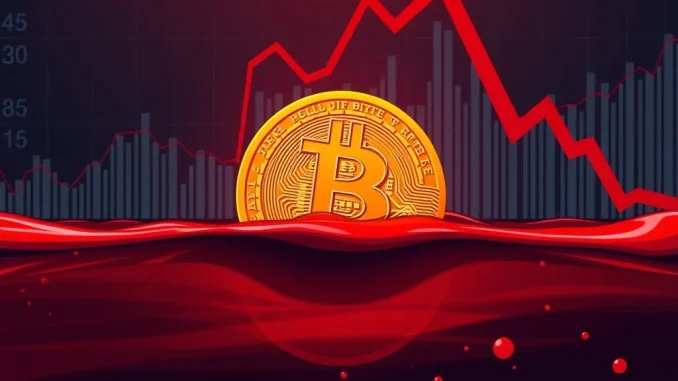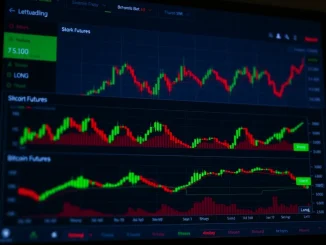
The cryptocurrency market is buzzing, and not always for the best reasons. If you’re tracking the pulse of digital assets, you’ve likely noticed the recent tremors. Bitcoin news today paints a picture of heightened volatility, with significant implications for traders and investors alike. A recent 2.6% dip in Bitcoin’s price has sent ripples through the market, fueled by an astonishing surge in open interest and a formidable build-up of short positions. This combination creates a precarious environment, where the potential for forced liquidations looms large, threatening to trigger abrupt price swings.
Understanding the Looming Threat of $44.5 Billion Open Interest
What exactly is ‘open interest,’ and why should it grab your attention when discussing the Bitcoin price? Open interest represents the total number of outstanding derivative contracts (like futures or options) that have not yet been settled. When this figure climbs, it signals increased speculative activity and leverage in the market. Recently, open interest across major exchanges soared to a record $44.5 billion, even as Bitcoin’s price softened below $116,000.
- A Double-Edged Sword: While high open interest can indicate growing market participation, its rise amidst a declining price suggests a significant influx of new short positions. This scenario often attracts speculators looking to profit from downward movements rather than long-term investors, amplifying market fragility.
- Amplified Risk: CryptoQuant analysts highlight that this dynamic heightens the risk of abrupt price swings. The more leverage in the system, the more sensitive the market becomes to even minor price movements.
- Historical Context: Historically, periods of high open interest coupled with price dips have often preceded significant volatility, making it a critical metric for traders to monitor.
The Dire Consequences of $9 Billion in Short Positions: A Crypto Liquidation Trigger?
The accumulation of massive short positions is a key concern in the current market landscape. A short position is a bet that an asset’s price will fall. When Bitcoin’s price hovers near critical thresholds, these positions become vulnerable. According to recent analyses, if Bitcoin were to cross the $125,000 mark, over $9 billion in short positions could face liquidation.
What happens during a liquidation cascade?
- Forced Buy-Backs: When a short position is liquidated, the trader’s exchange automatically buys back the asset to close the position.
- Upward Pressure: A large volume of forced buy-backs can create sudden, intense buying pressure, rapidly pushing prices higher in a ‘short squeeze.’
- Market Momentum: As Crypto Lord’s analysis underscores, leveraged traders often dictate momentum during sharp price reversals. This means that while the current setup suggests bearish sentiment from shorts, a sudden reversal could lead to a rapid upward surge driven by these forced closures.
This scenario underscores the leverage-driven nature of current market conditions, where even minor price movements could cascade into widespread position closures, creating significant market turbulence.
Retail vs. Institutional: Who’s Driving the Bitcoin Price Today?
A notable shift in market participation has been observed. While the earlier bull cycles, particularly 2021-2022, saw significant retail investor engagement absorbing dips, the current 2023-2025 phase appears to be dominated by institutional and large-cap players. CryptoQuant data reveals that the surge in open interest stems largely from speculative bets rather than long-term investment, further increasing vulnerability to sudden directional shifts.
Quinten’s six-year analysis provides a compelling perspective:
- 2021-2022 Cycle: Retail traders were key buyers during price corrections, often ‘buying the dip.’
- 2023-2025 Cycle: Large investors have reemerged as the primary buyers. This suggests that everyday traders might be taking profits or exiting positions, ceding control to institutional actors.
This shift implies that the market’s sensitivity to large institutional moves, such as significant sales or purchases, has increased. It also means that retail sentiment, while still important, may have less direct impact on immediate price movements compared to the actions of major players.
Recent Market Corrections: What Caused the $721 Million Crypto Liquidation?
The fragility of leveraged positions was starkly highlighted in late July. Bitcoin’s price fell 2.6% within 24 hours, dropping to $115,300. This relatively modest price drop triggered a massive $721 million in liquidations across major tokens. Breaking down the impact:
- Bitcoin Longs Hit Hard: $155.5 million in Bitcoin long positions were liquidated, meaning traders who bet on price increases faced significant losses.
- XRP Also Affected: $49 million in XRP positions also faced liquidation, indicating broader market distress beyond just Bitcoin.
- Galaxy Digital’s Influence: Galaxy Digital’s sale of 12,850 BTC (approximately $1.51 billion) exacerbated the selling pressure. This highlights how large institutional sales can significantly influence price dynamics, especially in a leveraged market.
The Altcoin Season Index concurrently dropped to 40, reflecting waning enthusiasm for smaller-cap tokens as Bitcoin’s dominance and volatility took center stage. This kind of widespread crypto liquidation event serves as a stark reminder of the risks associated with highly leveraged trading.
Navigating the Volatility: What Do Technicals and Sentiment Tell Us?
The recent dip has worsened technical indicators, with Bitcoin falling below key support levels. Traders are now closely monitoring the $116,000 threshold for potential stabilization. The BTC volatility index briefly rebounded to 1.27% from its July peak, signaling lingering uncertainty as monthly options approach expiry.
Analysts attribute much of this short-term turbulence to:
- Institutional Rotation Strategies: Large funds often rebalance their portfolios, which can involve selling off certain assets to reallocate capital.
- Profit-Taking: Large holders who bought at lower prices might be cashing out some gains, contributing to selling pressure.
Despite these short-term headwinds, ETF inflows continue to hint at a long-term bullish sentiment, suggesting that while some players are taking profits, new institutional money is still entering the market with a longer-term view.
Is the Crypto Fear & Greed Index Misleading?
Retail investor sentiment remains mixed. The Crypto Fear & Greed Index still signals “Greed,” with many viewing corrections as buying opportunities. However, experts caution that overconfidence amid technical weaknesses could prolong the downturn. Galaxy Digital’s continued BTC sales and the broader liquidation frenzy underscore the risks of overextended long positions, particularly as open interest remains elevated.
While niche tokens like Vine and Pepecoin saw gains during the broader selloff, indicating some capital rotation into smaller, speculative plays, the overall market trajectory remains uncertain. With nearly 208,000 traders liquidated in a single day and institutional activity driving price swings, the balance between macroeconomic optimism and near-term technical fragility will likely shape Bitcoin’s next move.
Key Takeaways and Actionable Insights
The current Bitcoin market is a high-stakes environment, characterized by significant leverage and a delicate balance between bullish long-term sentiment and immediate downside risks. Here are some key takeaways:
- Leverage is a Double-Edged Sword: While it can amplify gains, it dramatically increases liquidation risk during volatility. Understand your exposure.
- Monitor Open Interest: High open interest, especially when coupled with declining prices, signals increased speculative activity and potential for large price swings.
- Institutional Impact: Large institutional moves (like Galaxy Digital’s sales) can have a profound and immediate impact on price, often overriding retail sentiment in the short term.
- Risk Management is Paramount: Given the potential for rapid liquidations, employing robust risk management strategies, such as setting stop-losses and avoiding excessive leverage, is crucial.
- Long-Term vs. Short-Term: Differentiate between short-term market turbulence driven by liquidations and institutional profit-taking, and the longer-term bullish sentiment indicated by factors like ETF inflows.
For traders, understanding these dynamics is vital for navigating the current market. The interplay of record open interest, massive short positions, and shifting institutional dominance creates a landscape where vigilance and informed decision-making are more critical than ever.
Conclusion: Navigating the High-Stakes Bitcoin Arena
The recent dip in Bitcoin’s price, coupled with soaring open interest and a significant accumulation of short positions, has undeniably heightened market tensions. The potential for a massive crypto liquidation event, triggered by a short squeeze, underscores the inherent risks in a highly leveraged environment. While institutional players increasingly dictate momentum, the market remains susceptible to rapid shifts driven by position closures. As the industry grapples with this volatility, maintaining a clear perspective on both short-term technical indicators and long-term investment trends will be key to making informed decisions in this dynamic digital asset landscape.
Frequently Asked Questions (FAQs)
Q1: What does $44.5 billion in open interest mean for Bitcoin?
A1: $44.5 billion in open interest signifies a record amount of outstanding derivative contracts for Bitcoin. When this figure is high, it indicates increased speculative activity and leverage in the market. If prices move against the dominant position (in this case, many new short positions), it can lead to large liquidations and rapid price swings.
Q2: How do $9 billion in short positions spark liquidation risks?
A2: Short positions are bets that Bitcoin’s price will fall. If Bitcoin’s price rises significantly, these short positions will incur heavy losses. Exchanges will then automatically close these positions (liquidate them) by buying Bitcoin on the open market. If $9 billion in shorts are forced to buy back Bitcoin, it could create immense buying pressure, causing a rapid price surge known as a short squeeze.
Q3: What is the difference between retail and institutional investor behavior in the current market?
A3: In the current 2023-2025 cycle, institutional and large-cap investors appear to be the primary buyers during dips, whereas in previous cycles (like 2021-2022), retail traders were more prominent in ‘buying the dip.’ This suggests that institutional actions, such as large sales or purchases, have a more significant immediate impact on the Bitcoin price today.
Q4: What caused the recent $721 million crypto liquidation?
A4: The recent 2.6% dip in Bitcoin’s price, coupled with the influence of a large sale of 12,850 BTC by Galaxy Digital, triggered the liquidation of $721 million across various tokens. This included significant Bitcoin long positions and XRP positions, highlighting the cascading effect of even moderate price movements in a highly leveraged market.
Q5: Should I be concerned about the Crypto Fear & Greed Index showing ‘Greed’ during a market dip?
A5: While the Crypto Fear & Greed Index showing ‘Greed’ might suggest optimism, experts caution against overconfidence during periods of technical weakness. In a market with high open interest and liquidation risks, over-leveraged long positions can be dangerous. It’s crucial to balance sentiment with technical analysis and robust risk management.



